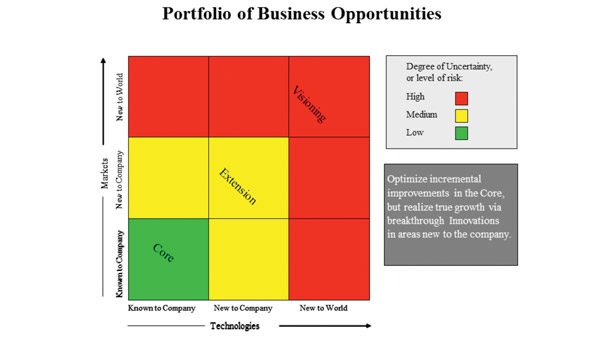Strategic Solutions: Corporate Leadership

How can an organization make the transition from mere market presence to true market leadership?
Much has been written about how an individual or company can become a more effective leader. But what defines true market leadership, and how can an organization make the transition from mere market presence to true market leadership within an industry?
It is useful to begin by examining what corporate leadership is not. First, leadership does not necessarily equate to overall size. That is, the biggest companies may “lead” the industry in size and mass, but may not always demonstrate leadership. The same can be said for companies with the largest share in a particular market segment. Again, they may “lead” a particular market segment, but they may not truly be leaders. Third, self-proclamations of being a “leading” supplier seldom equate to true market leadership. Finally, the company that makes the most profit is not necessarily a leader, although it could be argued that this attribute has the closest correlation with true corporate leadership.
Innovation
If overall size, market share and profit do not define corporate leadership, what does? One of the first areas of definition involves innovation. Admittedly, this tends to be a standard, almost trite, “differentiator,” but it requires closer scrutiny. Many companies like to point to a high percent of their sales that are spent on R&D and call themselves innovative. Yet true innovation is more than just a big portfolio of patents. Close inspection of many patents today shows them to be mere incremental improvements of existing technology platforms—which is hardly innovative in the classical sense. Instead, truly progressive companies see their markets differently and “re-vision” their corporate efforts toward that new reality (see Figure 1). Apple Inc. is a great example of this. iPods and iPads did not exist until Apple envisioned them—after which everyone found that they “needed” these items.
Innovation is also not solely relegated to a physical product or technology, as it can also be equally effective in devising new services. For example, both FedEx and UPS have evolved from just delivering packages to offering a full range of logistical management services. The challenge for adhesives and sealants manufacturers is to envision new applications for their products where none are currently used, or to give current products additional functional capabilities (e.g., strong adhesion and heat dissipation). Products that have been developed to stick better or cure faster are great, but these would not necessarily be considered leading technologies.
A Common Vision
Another characteristic of companies that exhibit market leadership are those that have an internal shared value throughout the whole organization. It is one thing to have a defined corporate strategy. It is something else entirely to have the workforce as a whole sharing and acting upon a common vision. Leadership within companies should not be viewed as something that is relegated to the boardroom and flows out from there. Truly great companies let leadership flow equally in both directions: from the top down and from the bottom up. In addition, in a world where corporate ethics are often called into question, great companies with that internal shared vision also have a built-in moral compass that tends to keep them on the right path.
The outward implication of all of this is that great companies are then better able to partner with their customers to jointly exploit new innovative applications and/or devise unique, favorable services. All companies espouse the desire to partner with their customers, but not all do this well. A company’s ability to have a shared internal vision makes it much easier to develop and cultivate a mutually beneficial shared vision with its customers.
Taking Time for Reflection
Companies that aspire to be true leaders cannot be afraid of mirrors, which means that they cannot shy away from a very candid and continual analysis of who they are. This is not to suggest that they become so internally focused as to forget that there is an outside world (which many companies often tend to do). Instead, great organizations are able to recognize that they do not know it all and are willing to seek outside assistance to better understand market trends, drivers and unmet needs, or to conduct customer surveys by outside third parties to get an “unvarnished” assessment of how their customers see them.
Too often, companies that “lead” a market segment develop a myopic attitude about that market and implement strategies that may be built on incomplete and/or biased information. On occasion, good corporate leadership can even spawn a nasty case of corporate arrogance. Great organizations are those that have learned how to learn and are willing to accept outside, independent input and feedback—however “painful” it might be. Again, not being afraid of a mirror can assure that the pride and confidence that great companies develop does not devolve into a corporate personality that puts off current or potential customers.
Adaptability
All corporations typically strive to develop cohesive strategies to guide their company’s efforts. Companies that show real leadership, though, are those that have the unwavering discipline to execute all elements of their strategy—and also have the confidence and capability to adapt to changing external conditions. It is this adaptive quality (often based on almost “real-time” market feedback) that allows great companies to understand what is actually happening in its markets and identify opportunities for new innovative products and/or services.
Companies without this discipline and/or real-time feedback tend to stick with an ill-fated strategy for far too long and/or miss out on potential promising opportunities. An organization’s ability to keep a fresh, invigorating strategy is a hallmark of true corporate leadership.
Steady Profits
Finally, in a capitalist system, it is not crass to embrace the fact that companies are in business to make money to benefit their many stakeholders. It is also not hard to see that good companies and great companies alike make money. The big distinction, however, comes from the sustainability of that profit stream.
Good companies will have good years and bad years. Conversely, great companies will exhibit a profit continuity that stems from their steady stream of innovative products and services, a shared vision with their customers, and an innate ability to adjust to external factors. While big companies may make more money when times are good, companies that have an inherent leadership quality will also make money during challenging times.
Final Thoughts
As companies emerge from the protracted economic abyss of the past several years, everyone aspires to assume their rightful position as a market leader. Yet there is much more to being a true market leader, vs. a company with a presence within a given market, even if that position is #1. While final financial results are certainly important, true corporate leadership is much more related to the process involved than the final sales or profit numbers. In short, a company with good financials may not be a great company, but a company that exhibits true market leadership will assuredly have good numbers.
About the Author
Richard B. Jones is vice president of The ChemQuest Group Inc., an international strategic management consulting firm specializing in the adhesives, sealants, and coatings industries, headquartered in Cincinnati.
For more information, phone (513) 469-7555 or visit www.chemquest.com.
Looking for a reprint of this article?
From high-res PDFs to custom plaques, order your copy today!





